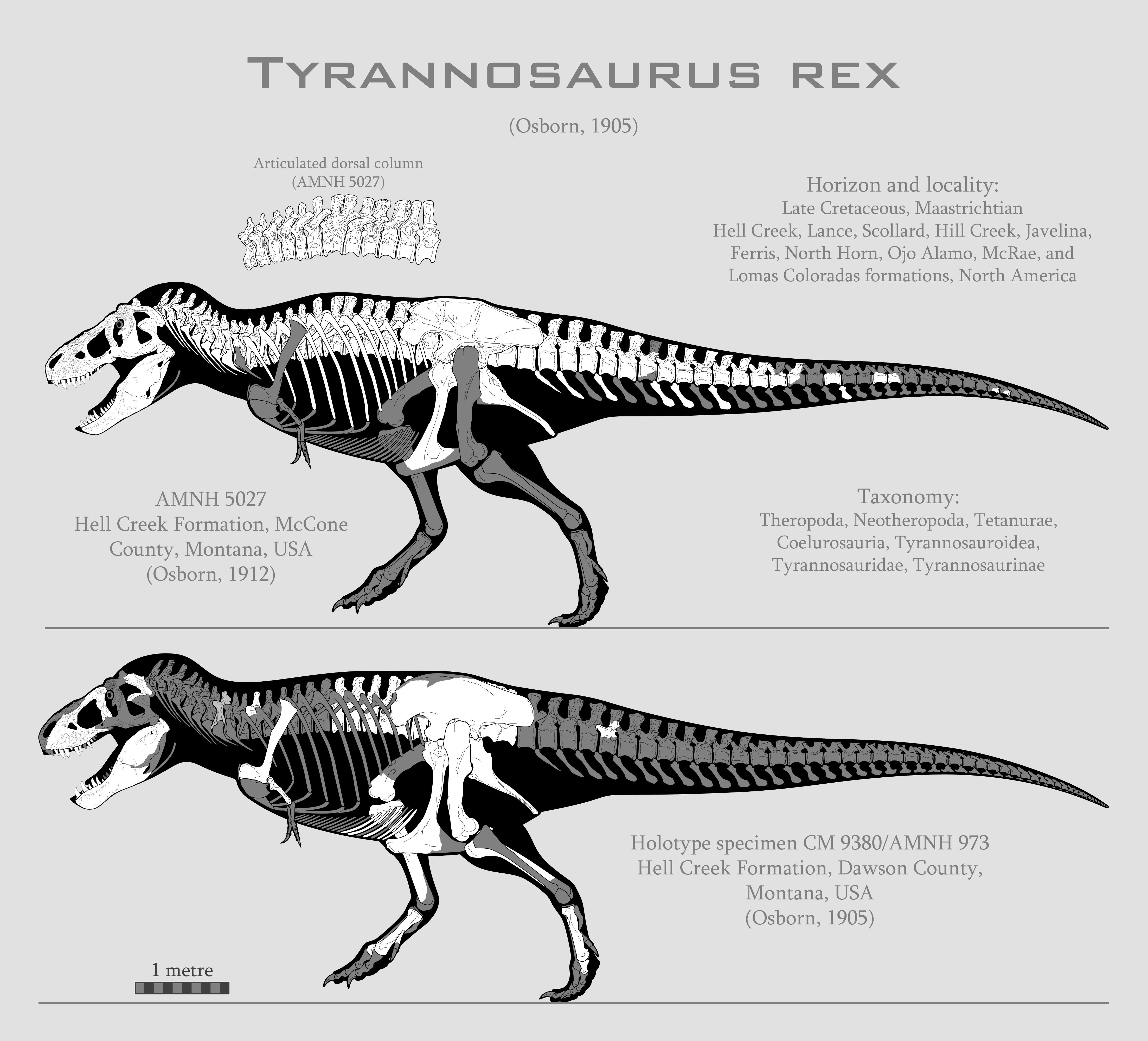Tyrannosaurus rex (“King of the tyrant reptiles”) is a species of gigantic theropod dinosaur that lived during the latest Cretaceous in what is now North America. A probable immigrant from East Asia, it rose to the niche of apex predator in western North America (Laramidia), possibly outcompeting the native albertosaurs and might have displaced them geographically, relegated them to mesopredators, or perhaps even drove them to extinction. Tyrannosaurus rex was one of the largest theropods, larger than a bull African elephant. It mainly preyed on hadrosaurs, ankylosaurs, and ceratopsians, but juvenile and subadult titanosaurs were not off the menu.
Despite the common conception about the sexual dimorphism of T. rex, there is no actual evidence at all that female T. rex were larger overall. Nor is there any evidence for the reverse, for that matter.
Between 50 or more specimens, nearly the entire skeleton of T. rex is known save for the very tip of the tail. T. rex had a fairly standard anatomy for tyrannosaurids – large, powerful hindlimbs adapted for speed and endurance, a massive skull adapted for crushing forces, a broad ribcage (up to ~1.6 metres for the largest known specimens such as FMNH PR2081), reduced arms with didactyl hands (while the third digit remains, it only does so as a vestigal metacarpal that would not have been visible in life), and a long tail comprising more than 50% of the total length.
The specimens restored here are fairly typical adult specimens – the holotype CM 9380 (formerly AMNH 973) and one of the most complete adult T. rex, AMNH 5027, only behind FMNH PR2081 and BHI 3033 in terms of skeletal completeness. These two specimens are of very similar size, even having the same ilium length (~1.515 metres) and due to this fact, most of the missing portions in each specimen were filled in with parts from the other. The remaining gaps were filled in with other specimens, namely FMNH PR2081 and BMNH R7994 (formerly AMNH 5866).
When it was first mounted, the restored skeleton of AMNH 5027 was restored at more than 13 metres long due to an excessively long tail. The mounted skeleton of AMNH 5027 still possesses the original restored tail, and thus remains the longest mounted theropod skeleton in the world. More complete specimens discovered later on (such as the aforementioned FMNH PR2081 and BHI 3033) revealed enough data about the caudal series to show that 13+ metre lengths are excessive for even the largest known T. rex.
A notable characteristic in the dorsal series of AMNH 5027 is the fused pair of middle dorsals (dorsals 7 & 8) which forces the rest of the dorsal series to articulate in a mildly “humped” manner. Most skeletal restorations have omitted this feature in favour of a generalised back, and while this would have been more representative of a generic specimen, they end up further from being true-to-life restorations of AMNH 5027 specifically. Refraining from this trend of generalising the dorsal column, this restoration is thus one of the few true restorations of the actual AMNH 5027, rather than a generic “AMNH 5027-type” specimen.
Reconstructed dimensions
- AMNH 5027
- Hip height: ~3.47 metres
- Back height: ~3.54 metres
- Shoulder height: ~3.24 metres
- Total height: ~3.64 metres
- Standing length: ~11.23 metres
- Axial length: ~11.63 metres
- CM 9380/AMNH 973
- Hip height: ~3.47 metres
- Back height: ~3.5 metres
- Shoulder height: ~3.2 metres
- Total height: ~3.68 metres
- Standing length: ~11.3 metres
- Axial length: ~11.68 metres
References
- Osborn, 1905, “Tyrannosaurus and other Cretaceous carnivorous dinosaurs”
- Osborn, 1906, “Tyrannosaurus, Upper Cretaceous carnivorous dinosaur”
- Osborn, 1912, “Crania of Tyrannosaurus and Allosaurus”
- Osborn, 1917, “Skeletal adaptations of Ornitholestes, Struthiomimus, Tyrannosaurus”
- Brochu, 2003, “Osteology of Tyrannosaurus rex: insights from a nearly complete skeleton and high-resolution computed tomographic analysis of the skull”
- Hutchinson et al., 2011, “A computational analysis of limb and body dimensions in Tyrannosaurus rex with implications for locomotion, ontogeny, and growth”
- Persons et al., 2019, “An older and exceptionally large adult specimen of Tyrannosaurus rex”
- Theropod Database – Tyrannosaurus rex
Published: April 12, 2019
Last update: October 1, 2022
